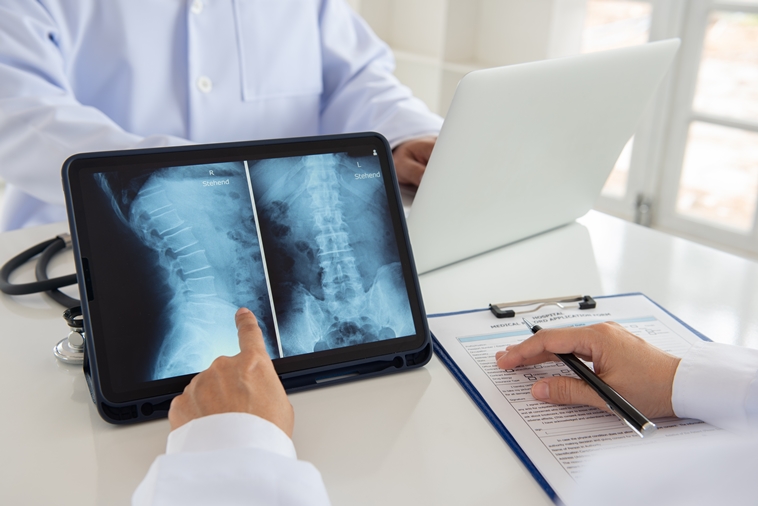A herniated disc can be painful, and many people who experience this type of pain refer to it as “a pinched nerve.” However, though the physical pain that is occurring might give the feeling of “pinching,” a herniated disc is not the same thing.
So what exactly is a herniated disc? And are there treatment options outside of surgery? Let’s get into both of those questions.
What is a Herniated Disc?
There is not just one type of disc herniation that can occur in the body. In fact, there are three: Lumbar (lower back), cervical (neck), and thoracic (upper back). However, you’ll notice that all three locations occur along the spine, and the act of herniation happens in a similar fashion regardless of which part of the spine it is located.
Specifically, a herniated disc happens when one of the intervertebral discs, which separates the vertebrae of the spine, ruptures. When this occurs, the gel-like inner material of the disc breaks through a crack in the outer coating. This creates a pressure that presses on spinal nerves and causes pain, numbness and weakness. This specific pain and pressure is what leads some people to refer to their condition as a pinched nerve.
Additionally, a herniated disc is not to be confused with a bulging disc—another misconception. If you are experiencing a bulging disc, this means that the degenerating disc material is bulging out between the vertebrae, but not breaking through its outer coating. While this is still a painful scenario, a bulging disc is less likely to interfere with spinal nerves.
Usually, herniated discs are caused by deterioration of the spine, which is common and due to aging. This doesn’t mean that everyone is going to develop a herniated disc at some point in their life, but the frequency means there is a great deal of knowledge around how they occur and how they can be maintained.
There are also ways that herniation may occur outside of old age and natural deterioration. For instance, if the spine experiences trauma, it could cause herniation. Whether this is from heavy lifting or a sudden twist that the spine didn’t agree with, there are ways a disc can spontaneously herniate.
What are the Symptoms of a Herniated Disc?
Just like all bodies are not the same, all herniated discs don’t have the same symptoms. And these symptoms can vary further depending on where the herniation is located along the spine. Even so, there are some symptoms that are more common than others.
Pain or even numbness lingering in the arm, shoulder, or sometimes the legs can be a symptom of a herniated disc. Along with this pain or numbness is often weakness as well. Sometimes movement of the spine can cause sharp pains that happen instantly. In some severe instances, a herniated disc along the lumbar spine can cause nerve compression, which can limit or even prevent bowel or bladder function.
If you are experiencing symptoms, listen to your body to better understand where the herniated disc is located. For instance, if your symptoms are happening in the shoulders or arms, there is a good chance the herniation has occurred in the neck. If your symptoms are occuring in the rib cage, chest, or upper abdomen, you likely have a herniation in your upper back. And ultimately, lumbar disc herniations tend to cause intense pain below the wait, such as the buttocks, thigh, calf, and sometimes, in serious instances, the pain can reach to the ankle or foot.
What are Non-Surgical Herniated Disc Treatment Options?
At Desert Spine & Scoliosis Center, we believe in a conservative approach to the management and treatment of all conditions that pertain to the spine. And while some rare herniated discs are emergencies and require immediate response, we want to explore all treatment options with you before making a decision.
Exercise, first and foremost, is a very crucial component in the treatment of herniated discs. Exercise is also a solid preventative treatment, so if you are out of shape or perhaps over weight, exercising is a good habit to get into.
There are also herniated disc treatments you can do at home, such as applying ice to the painful area. Heat pads are also a remedy, as it will sooth the area and help it relax. These are best and most effective when applied shortly after the pain appears.
Sometimes the body needs a bit of a boost, in which medications can help as well as injections which will aid the body and reduce pain. In these instances, symptoms and pain usually resolve within a few days or weeks, depending on the severity of the herniated disc. It is often the case that pain is the first symptom to retreat. Numbness, tingling, or weakness tend to linger for a longer amount of time, but often resolve.
Whatever your situation, it is best to know all your options so you can maintain your disc herniation appropriately and get back to enjoying life. Book a consultation with us today, and let’s discuss what makes sense for your treatment plan.



Recent Comments